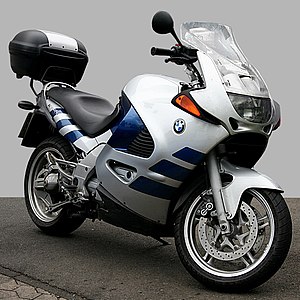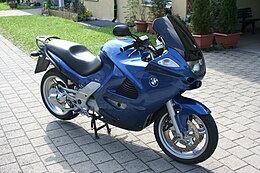BMW K 1200 RS
| BMW | |
|---|---|
 Model code K589 (1997-2000) |
|
| K 1200 RS | |
| Manufacturer | BMW |
| Sales description | K 1200 RS |
| Production period | 1997 to 2005 |
| class | motorcycle |
| design type | Sports Tourer |
| Motor data | |
| In-line engine with 4 cylinders | |
| Displacement (cm³) | 1171 |
| Power (kW / PS ) | 96/130 at 8750 min -1 |
| Torque ( N m ) | 117 Nm at 6750 min -1 |
| Top speed ( km / h) | 247 |
| transmission | 6-speed sequential |
| drive | Cardan |
| Brakes | front Ø 305 mm double disc brakes, rear Ø 285 mm disc brake |
| Wheelbase (mm) | 1549 |
| Dimensions (L × W × H, mm): | 2250 × 850 × 1200 |
| Seat height (cm) | 76.9-79.3 |
| Empty weight (kg) | 285 |
| Previous model | BMW K 1100 RS |
| successor |
BMW K 1200 GT BMW K 1200 S. |
The BMW K 1200 RS is a long-distance motorcycle from BMW with a cardan drive . The sports tourer is the last evolutionary stage of the BMW four-cylinder with a longitudinal engine ( called Flying Brick in motorcyclist jargon). From 1997 to 2005, 37,992 units were built at the BMW plant in Berlin in Spandau , of which 13,352 were registered in Germany.
Model development
The RS weighs 295 kg with a full tank (according to another source 285 kg). Until 2000 the factory code was K589. For the year of construction 2001 the RS was revised under the new model code K547. The front paneling was changed, the window was enlarged and the seating position was made a little less sporty by placing the footrests down and the handlebars a little higher. In addition, the ABS2 was replaced by the integral ABS, which was initially available as an option.
Production of the K 1200 RS with a longitudinal engine ended in 2005. The almost identical K 1200 GT (version with longitudinal engine) was also discontinued in 2006. Only the luxury tourer K 1200 LT was built until 2007. The K 1200 GT (built between 2006 and 2008) and the sporty K 1200 S (built between 2004 and 2009), both with a transverse engine, can best be described as direct successors to the K 1200 RS .
Technical specifications
drive
The liquid-cooled in-line four - cylinder engine has a displacement of 1171 cm³ ( bore 70.5 mm, stroke 75 mm). The rated output is 96 kW (130 hp), the maximum torque of 117 Nm at 6750 min -1 . The engine is installed lengthways and has two chain-driven overhead camshafts that control two intake and two exhaust valves per cylinder via bucket tappets. Compared to the previous engine of the K 1100, the stroke has been increased by 5 mm. The intake system is supported by dynamic pressure charging, which is supplied with air through an opening in the front panel.
The motorcycle accelerates from 0 to 100 km / h in 3.3 seconds and reaches a top speed of 245 km / h. Due to a manufacturer's self-restraint, in Germany and France the motorcycle was mostly delivered in a version reduced to 72 kW (98 PS) until 2001. This is characterized by a slightly higher torque at a significantly lower speed (118 Nm at 5500 rpm) and is therefore better suited for operation with two people and relaxed cruising. It also reaches maximum output much earlier at a speed of 7000 rpm. The K 1200 RS was one of the first motorcycles to have a fully digitized ignition and injection system - a Motronic from Robert Bosch GmbH .
Power transmission
The power is transmitted from the engine to the gearbox with gears ( primary drive ). The clutch is a hydraulically operated single-plate dry clutch, the transmission has six gears. The secondary drive takes place via a cardan shaft with a torque support called a Paralever , which reduces the rise of the tail when accelerating heavily.
Fuel supply
The fuel is prepared by a fuel injection system that is controlled by a Motronic MA 2.4 from Bosch with overrun fuel cutoff . The fuel tank has a capacity of 22 liters, of which 4 liters are in reserve. The manufacturer recommends the use of petrol with a knock resistance of at least 95 octane and specifies a theoretical range of 312 km. The average fuel consumption is 6.9 liters per 100 km.
The K 1200 RS has two regulated catalytic converters for exhaust aftertreatment and complies with the Euro-2 emissions standard .
landing gear
The chassis is built on a cast aluminum frame. At the rear it has a double-jointed single-sided swing arm, the front wheel is guided by a Telelever . The rear wheel is offset by 5 mm to compensate for the slight excess weight on the right side.
The front wheel has a Brembo double disc brake with four-piston brake calipers, the rear wheel has a disc brake with two-piston brake caliper. A standard anti-lock braking system supports the deceleration on both brakes. The lean angle is 50 degrees.
BMW has suppressed the unpleasant vibrations of previous K models by separating the drive unit from the frame and using rubber insulation. The long wheelbase of 1549 mm ensures good driving stability. The bench is adjustable in height from 769 to 793 mm.
Model history
- 1997 Market launch of the K 1200 RS as the first K model with Telelever and cast aluminum frame
- 1999 Changed pistons for lower oil consumption
- 2000 Discontinuation of the 98 hp power variant, now 130 hp as standard
- 2001 New upper part of fairing and larger windshield, EVO brake on the front wheel, partially integral ABS now standard, new indicators and larger rear-view mirrors, comfort handlebars as standard (lower handlebars still available as special accessories), lower-positioned footrests; for rider by 30 mm, for pillion by 20 mm
- 2002 steady light, maintenance-free battery
- 2006 Sale after production stop the year before
Weak points
According to Motorrad magazine , the K 1200 RS has weaknesses that should be considered when buying a used vehicle.
“ABS failures are not uncommon for specimens with high mileage without regular workshop maintenance (check the checkbook). If there is already a defect (it is best to have a professional checked), hands off! The repair of this component costs around 2000 euros. Also look for leaks in the fork, gearbox output and axle drive and check whether the electrical system and displays are working properly. When taking a test drive, pay attention to the clutch, which is often badly used after 30,000 kilometers. Normal: Oil consumption of up to half a liter per 1000 kilometers. With proper maintenance (good sign: few previous owners), the durable 1200 is a solid bank, so that mileage well over 50,000 kilometers should not deter you from buying. Accessories hardly play a role in this model, as it was usually extensively equipped as a new vehicle. "
Reviews
“On the road, the BMW K 1200 RS convinces with its unobtrusive manner. It does not seduce the driver into a fast-paced style of driving, as is often the case with sporty motorcycles. Nevertheless, it can also be moved extremely quickly on all kinds of roads. The motor, which is decoupled from vibrations due to the newly designed frame, no longer passes its vibrations on to the driver, inspires in every driving situation. "
“The motorcycle that finally freed the K-series from its reputation of“ flying bricks ”is an astonishingly fast touring athlete and a successful alternative to Italian and Japanese machines. In contrast to most other BMWs, it has a 4-cylinder in-line engine, which contributes significantly to the weight of the machine, which is not a lightweight at 285 kg with a full tank. "
"The high-speed sprinter, equipped as standard with ABS, Kat and adjustable components such as windshield, handlebars, gearshift levers, driver's footrests and seat, is great for traveling and just as good for looking for more difficult angles at the weekend."
"Insane seating comfort, superior performance, easy-care cardan, adjustable windshield, variable seat height and ergonomics of the handlebars - great, a perfect travel device! In the winding target area, the driver is happy about the driving dynamics, which are comparatively high for the high weight, as well as the long-stroke, elastic row quad, which pushes out around 100 Nm of torque at just over 4000 rpm. "
See also
Web links
- BMW Motorrad Germany
- Waldemar Schwarz: Endurance test BMW K 1200 RS (engine failure) - A Munich man in heaven. In: Motorrad, issue 21/1997. October 7, 1997, accessed July 29, 2012 .
- Interest group BMW K 1200 RS
- History / development of the K 1200 RS at: flyingbrick.de
Individual evidence
- ^ All Motorcycles. Production models since 1923. (PDF; 77 kB) (No longer available online.) In: BMW Medieninformation. January 1, 2008, p. 86 , archived from the original on March 5, 2016 ; accessed on October 18, 2014 (English). Info: The archive link was inserted automatically and has not yet been checked. Please check the original and archive link according to the instructions and then remove this notice.
- ↑ a b c Jan Leek: Type compass BMW - motorcycles since 1945 . 1st edition, Motorbuch Verlag, Stuttgart 2012, ISBN 978-3-613-03475-4 , p. 116.
- ^ A b c Dieter Höhner: Travel & Sport . In: Motorcyclists . No. 05 , 2012, ISSN 0935-7645 , p. 45 .
- ↑ Longrunner . In: Touring Driver . Edition 7/2001. ISSN 0933-4440 .
- ↑ a b c Ulf Böhringer: A pretty dynamic chunk. In: Süddeutsche Zeitung . March 29, 1997, accessed September 29, 2014 .
- ↑ a b Thosten Dentges: The heavy tourer from BMW as used. In: motorcycle . June 6, 2012, accessed September 25, 2016 .
- ↑ Marcus Lacroix: BMW K 1200 RS. (No longer available online.) In: Kradblatt. June 1, 1997, archived from the original on April 19, 2012 ; Retrieved July 29, 2012 . Info: The archive link was inserted automatically and has not yet been checked. Please check the original and archive link according to the instructions and then remove this notice.
- ↑ Alan Dowds: Motorcycles: The World's Breathtaking Superbikes . Edition XXL, 2005, ISBN 3-89736-329-1 , pp. 420 .
